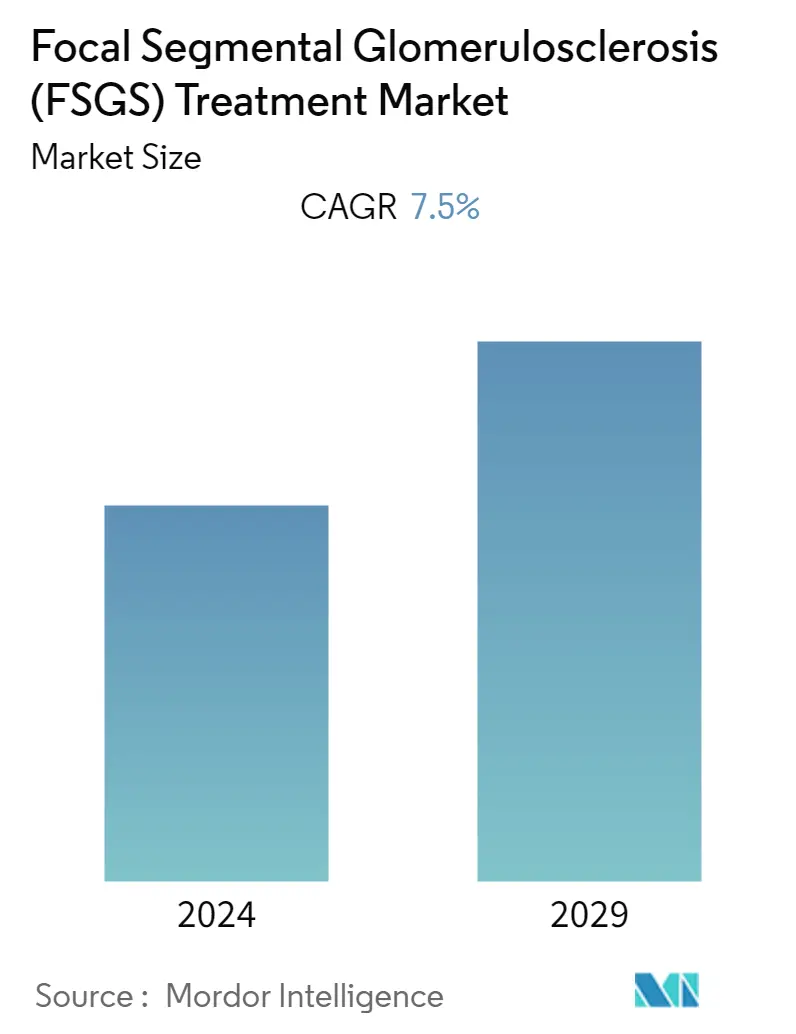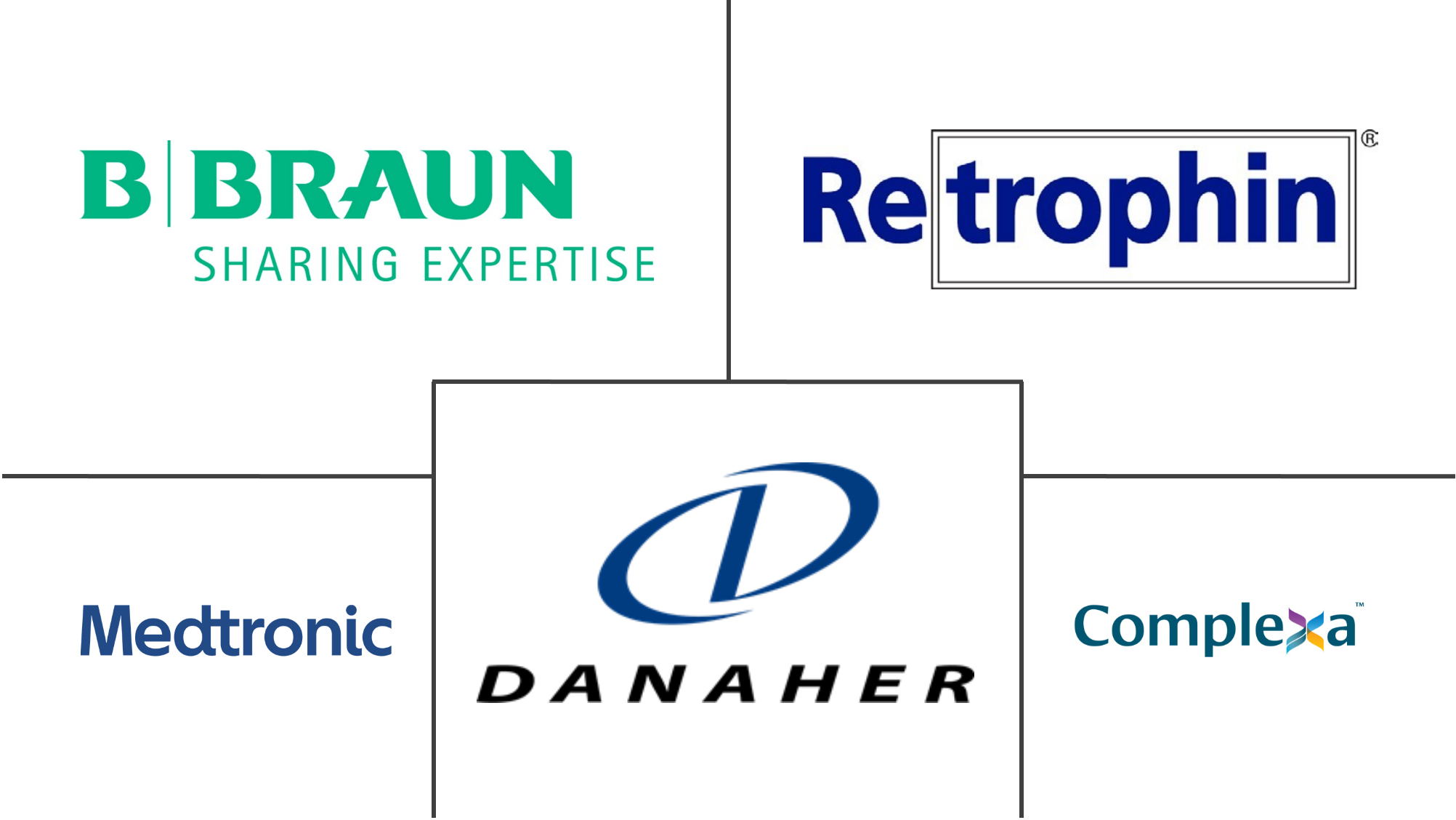Market Size of Focal Segmental Glomerulosclerosis (FSGS) Treatment Industry

| Study Period | 2021 - 2029 |
| Base Year For Estimation | 2023 |
| CAGR | 7.50 % |
| Fastest Growing Market | Asia-Pacific |
| Largest Market | North America |
| Market Concentration | High |
Major Players
*Disclaimer: Major Players sorted in no particular order |
Focal Segmental Glomerulosclerosis Treatment Market Analysis
The focal segmental glomerulosclerosis (FSGS) treatment market is expected to register a CAGR of 7.5% over the forecast period.
Although COVID-19 infection primarily affected the lungs, the cause of the nephropathy that developed as a result of COVID-19 infection was unknown because the damage could have been caused by another virus or kidney damage.Glomerular lesions were reported in a minority of patients with COVID-19, with collapsing focal segmental glomerulosclerosis (FSGS), also called COVID-associated nephropathy (COVAN). For instance, according to an article published by UpToDate, in November 2022, COVAN patients will be presented with nephrotic-range proteinuria and acute kidney injury. Similar to HIV-associated nephropathy, COVAN occurred exclusively in Africans, and a high proportion of those tested possessed high-risk APOL1 genotypes. Furthermore, according to an article published by Elsevier in December 2021, patients with focal segmental glomerulosclerosis associated with COVID-19 were treated with corticosteroids and cyclosporine. Hence, only a minority of patients associated with glomerular lesions were affected by COVID-19, and thereby the demand for FSGS treatment was unaffected during the pandemic.
Factors such as the increasing burden of focal segmental glomerulosclerosis (FSGS) and a high focus on developing new treatment options are major factors that are expected to drive growth in the market over the forecast period. For instance, according to an article published by MedSpace in October 2022, FSGS is one of the most common causes of primary glomerular disease in adults. FSGS accounts for 35% of all cases in adults undergoing kidney biopsy for proteinuria evaluation, and up to 80% of subjects in African-American patients.Furthermore, according to an article published by the National Library of Medicine in July 2022, FSGS is a frequently encountered cause of nephrotic syndrome, accounting for 40% of cases in adults and 20% in children. Such an increasing burden of FSGS is expected to drive the growth of the studied market.
In addition, a high focus on developing new treatment options is expected to drive the growth of this market over the forecast period. For instance, in February 2021, Travere Therapeutics, Inc. provided a regulatory update for its sparsentan program in focal segmental glomerulosclerosis (FSGS). The company conducted pre-new drug application interactions with the U.S. FDA in pursuit of an accelerated approval submission in the U.S. following the achievement of the interim proteinuria endpoint in the ongoing Phase 3 DUPLEX Study of sparsentan in FSGS, as well as pre-marketing authorization application interactions with the European Medicines Agency for conditional marketing authorization and accelerated assessment consideration in Europe. Over the next few years, the growth of the market is likely to be driven by efforts to find a new way to treat FSGS.
However, the high cost of dialysis and kidney transplants is expected to hinder market growth.
Focal Segmental Glomerulosclerosis Treatment Industry Segmentation
As per the scope of the report, focal segmental glomerulosclerosis is the progressive scarring of the kidney, which is characterized by proteinuria. It is among the rare diseases that affect kidney function by attacking and damaging the glomeruli. The focal segmental glomerulosclerosis (FSGS) treatment market is segmented by disease type (primary FSGS and secondary FSGS), disease management (diagnosis and treatment), and geography (North America, Europe, Asia-Pacific, the Middle East and Africa, and South America). The market report also covers the estimated market sizes and trends for 17 different countries across major regions globally. The report offers the value (in USD million) for the above segments.
| By Disease Type | |
| Primary FSGS | |
| Secondary FSGS |
| By Disease Management | |||||
| |||||
|
| Geography | ||||||||
| ||||||||
| ||||||||
| ||||||||
| ||||||||
|
Focal Segmental Glomerulosclerosis (FSGS) Treatment Market Size Summary
The focal segmental glomerulosclerosis (FSGS) treatment market is poised for significant growth, driven by the increasing prevalence of this condition and a strong focus on developing innovative treatment options. FSGS is a leading cause of primary glomerular disease in adults, particularly affecting African-American patients, and is a common cause of nephrotic syndrome. The market's expansion is supported by ongoing research and development efforts, with companies like Travere Therapeutics and Vertex Pharmaceuticals making strides in clinical trials and regulatory approvals for new therapies. Despite the challenges posed by high treatment costs, the market is expected to benefit from advancements in targeted therapies and strategic partnerships among specialty clinical-stage companies.
North America holds a dominant position in the FSGS treatment market, attributed to its well-structured healthcare infrastructure, comprehensive reimbursement policies, and a high adoption rate of new healthcare technologies. The United States, in particular, is a hub for clinical trials, with numerous studies underway to evaluate new drug candidates. The presence of major pharmaceutical companies and research institutions further bolsters the region's market share. Globally, the competitive landscape is characterized by the activities of both international and local companies, including B. Braun Melsungen AG, Beckman Coulter Inc., and Pfizer Inc. These companies are actively involved in the development and commercialization of FSGS treatments, contributing to the market's robust growth trajectory over the forecast period.
Focal Segmental Glomerulosclerosis (FSGS) Treatment Market Size - Table of Contents
-
1. MARKET DYNAMICS
-
1.1 Market Overview
-
1.2 Market Drivers
-
1.2.1 Increasing Burden of Focal Segmental Glomerulosclerosis (FSGS)
-
1.2.2 High Focus on Developing New Treatment Options
-
1.2.3
-
-
1.3 Market Restraints
-
1.3.1 High Cost of Dialysis and Kidney Transplant
-
-
1.4 Porter's Five Forces Analysis
-
1.4.1 Threat of New Entrants
-
1.4.2 Bargaining Power of Buyers/Consumers
-
1.4.3 Bargaining Power of Suppliers
-
1.4.4 Threat of Substitute Products
-
1.4.5 Intensity of Competitive Rivalry
-
-
-
2. MARKET SEGMENTATION (Market Size by Value - USD million)
-
2.1 By Disease Type
-
2.1.1 Primary FSGS
-
2.1.2 Secondary FSGS
-
-
2.2 By Disease Management
-
2.2.1 Diagnosis
-
2.2.1.1 Kidney Biopsy
-
2.2.1.2 Creatinine Test
-
2.2.1.3 Other Diagnoses
-
-
2.2.2 Treatment
-
2.2.2.1 Drug Therapy
-
2.2.2.2 Dialysis
-
2.2.2.3 Kidney Transplant
-
-
-
2.3 Geography
-
2.3.1 North America
-
2.3.1.1 United States
-
2.3.1.2 Canada
-
2.3.1.3 Mexico
-
-
2.3.2 Europe
-
2.3.2.1 Germany
-
2.3.2.2 United Kingdom
-
2.3.2.3 France
-
2.3.2.4 Italy
-
2.3.2.5 Spain
-
2.3.2.6 Rest of Europe
-
-
2.3.3 Asia-Pacific
-
2.3.3.1 China
-
2.3.3.2 Japan
-
2.3.3.3 India
-
2.3.3.4 Australia
-
2.3.3.5 South Korea
-
2.3.3.6 Rest of Asia-Pacific
-
-
2.3.4 Middle East and Africa
-
2.3.4.1 GCC
-
2.3.4.2 South Africa
-
2.3.4.3 Rest of Middle East and Africa
-
-
2.3.5 South America
-
2.3.5.1 Brazil
-
2.3.5.2 Argentina
-
2.3.5.3 Rest of South America
-
-
-
Focal Segmental Glomerulosclerosis (FSGS) Treatment Market Size FAQs
What is the current Focal Segmental Glomerulosclerosis (FSGS) Treatment Market size?
The Focal Segmental Glomerulosclerosis (FSGS) Treatment Market is projected to register a CAGR of 7.5% during the forecast period (2024-2029)
Who are the key players in Focal Segmental Glomerulosclerosis (FSGS) Treatment Market?
B. Braun Melsungen AG, Beckman Coulter Inc. (Danaher Corporation), Medtronic Plc, Retrophin Inc. and Complexa Inc. are the major companies operating in the Focal Segmental Glomerulosclerosis (FSGS) Treatment Market.

